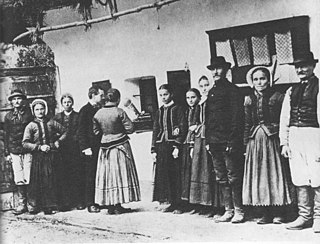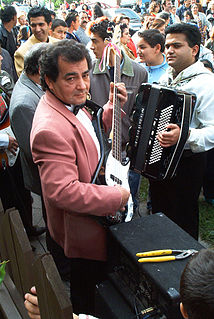Related Research Articles

Folk music is a music genre that includes traditional folk music and the contemporary genre that evolved from the former during the 20th-century folk revival. Some types of folk music may be called world music. Traditional folk music has been defined in several ways: as music transmitted orally, music with unknown composers, music that is played on traditional instruments, music about cultural or national identity, music that changes between generations, music associated with a people's folklore, or music performed by custom over a long period of time. It has been contrasted with commercial and classical styles. The term originated in the 19th century, but folk music extends beyond that.

The Romani, colloquially known as the Roma, are an Indo-Aryan ethnic group, traditionally nomadic itinerants. They live in Europe and Anatolia, and have diaspora populations located worldwide, with significant concentrations in the Americas.

Romani music is the music of the Romani people who have their origins in northern India but today live mostly in Europe.
Hungary has made many contributions to the fields of folk, popular and classical music. Hungarian folk music is a prominent part of the national identity and continues to play a major part in Hungarian music. It is also strong in the Szabolcs-Szatmár area and in the southwest part of Transdanubia. The Busójárás carnival in Mohács is a major Hungarian folk music event, formerly featuring the long-established and well-regarded Bogyiszló orchestra.
Romania is a European country with a multicultural music environment which includes active ethnic music scenes. Traditional Romanian folk music remains popular, and some folk musicians have come to national fame.

The music of Bulgaria refers to all forms of music associated with the country of Bulgaria, including classical, folk, popular music, and other forms.
Music of Serbia represents the musical heritage of Serbia, both historical and modern. It has a variety of traditional music styles, which are part of the wider Balkan musical tradition, with its own distinctive sound and characteristics.

Čoček is a musical genre and dance that emerged in the Balkans during the early 19th century. It features prominently in the repertoire of many Romani brass bands.

The davul, dhol, tapan, atabal or tabl is a large double-headed drum that is played with mallets. It has many names depending on the country and region. These drums are commonly used in the music of the Middle East and the Balkans. These drums have both a deep bass sound and a thin treble sound due to their construction and playing style, where different heads and sticks are used to produce different sounds on the same drum.
Balkan music is a type of music found in the Balkan region of Southeastern Europe. The music is characterised by complex rhythm. Famous bands in Balkan music include Taraf de Haïdouks, Fanfare Ciocărlia, and No Smoking Orchestra.
Chalga is a Bulgarian music genre. Chalga or pop-folk is essentially a folk-inspired dance music genre, with a blend of Bulgarian music and also primary influences from Greek, Turkish and Arabic.

Nicolae Linguraru is a Romani (Gypsy) manele singer.

Fanfare Ciocărlia is a twelve-piece Romani Balkan brass band from the northeastern Romanian village of Zece Prăjini. They are known for their fast, high-energy music with complex rhythms and high-speed staccato clarinet, saxophone, and trumpet solos.
Greek traditional music includes a variety of Greek styles played by ethnic Greeks in Greece, Cyprus, Australia, the United States and other parts of Europe. Apart from the common music found generally in Greece, each region of Greece contains a distinct type of folk music that originated from the region due to their history, traditions and cultural influences.

Gypsy jazz is a style of small-group jazz originating from the Romani guitarist Jean "Django" Reinhardt (1910–53), in conjunction with the French swing violinist Stéphane Grappelli (1908–97), as expressed in their group the Quintette du Hot Club de France. Because its origins are in France, Reinhardt was from the Manouche clan, and the style has remained popular amongst the Manouche, gypsy jazz is often called by the French name "jazz manouche", or alternatively, "manouche jazz" in English language sources. Some scholars have noted that the style was not named manouche until the late 1960s; the name "gypsy jazz" began to be used around the late 1990s.

Balkan brass, popularly known by the Serbian name Truba, is a distinctive style of music originating in the Balkan region as a fusion between military music and folk music. In recent years, it has become popular in a techno-synth fusion throughout Europe, and in pop music in the Anglo-American sphere and throughout the world. Songs like Worth It by Fifth Harmony have brought the style to a new audience. In traditional form, it is popular throughout the Balkans, especially in Serbia, North Macedonia, Bulgaria, Moldova and Romania, although the turbo-folk variety attracts larger audiences. The energetic and fast beats encourage dance and are egalitarian, often resulting in participation by the entire audience; this unpretentious relationship with audiences, highly charged energy and loud and joyful performances by highly skilled musicians has contributed to its successes. Fans of bands inspired by Balkan bands, such as Gogol Bordelo, often state that it is a type of music better experienced than listened to.

Yıldız İbrahimova is a Bulgarian singer of Turkish ancestry. Besides jazz, she has also recorded Bulgarian, Turkish, Gypsy and Russian folk songs. She married Ali Dinçer, a Turkish politician, also born in Bulgaria and former mayor of Ankara, in 1993. Since then she has lived in Turkey. Her husband died in 2007.

Xoraxane Roma in Balkan Romani language, are non-Vlax Romani people, who adopted Sunni Islam of Hanafi madhab at the time of the Ottoman Empire. Some of them are Derviş of Sufism belief, and the biggest Tariqa of Jerrahi is located at the largest Arlije and Gurbeti Muslim Roma settlement in Europe in Šuto Orizari, locally called Shutka in North Macedonia have their own Romani Imamand the Muslim Roma in Šuto Orizari use the Quran in Balkan Romani language. Many Romanlar in Turkey, are members of the Hindiler Tekkesi a Qadiriyya-Tariqa, founded in 1738 by the Indian Muslim Sheykh Seyfullah Efendi El Hindi in Selamsız.

Bulgarian wedding music is a genre of Svatbarska muzika or a "wedding music" style that evolved in the late 1960s in Bulgaria. Its popularity has spread in Europe and North America. This style of music is performed elaborately in weddings in a festive atmosphere, and also on other happy occasions. It was not given state privilege initially by the socialist regime of Bulgaria as it was considered folk music. The music is a fusion of "an eclectic array" of Bulgarian, Romani, Turkish and Macedonian music and is very popular in the southern Balkan region. Following the end of the People's Republic of Bulgaria in 1989, the popularity of wedding music has soared.
The history and development of jazz in Bulgaria was significantly influenced by the cultural and political changes in the country during the 20th century, which led to the emergence of a genre blending western jazz styles with Bulgarian folk music influences.
References
- 1 2 3 Levy, Claire (2007). "Diversifying the Groove: Bulgarian Folk Meets the Jazz Idiom" (PDF). Journal of Interdisciplinary Music Studies. 1 (2): 25–42.
- 1 2 Vasiliu, Alex (2019). "The Balkan tradition in contemporary jazz. Anatoly Vapirov". Artes. Journal of Musicology (20): 256–264. ISSN 2344-3871.
- ↑ Shomer, Enid (2007). "Balkan Jazz". Prairie Schooner. 81 (1): 92–95. ISSN 0032-6682. JSTOR 40638731.